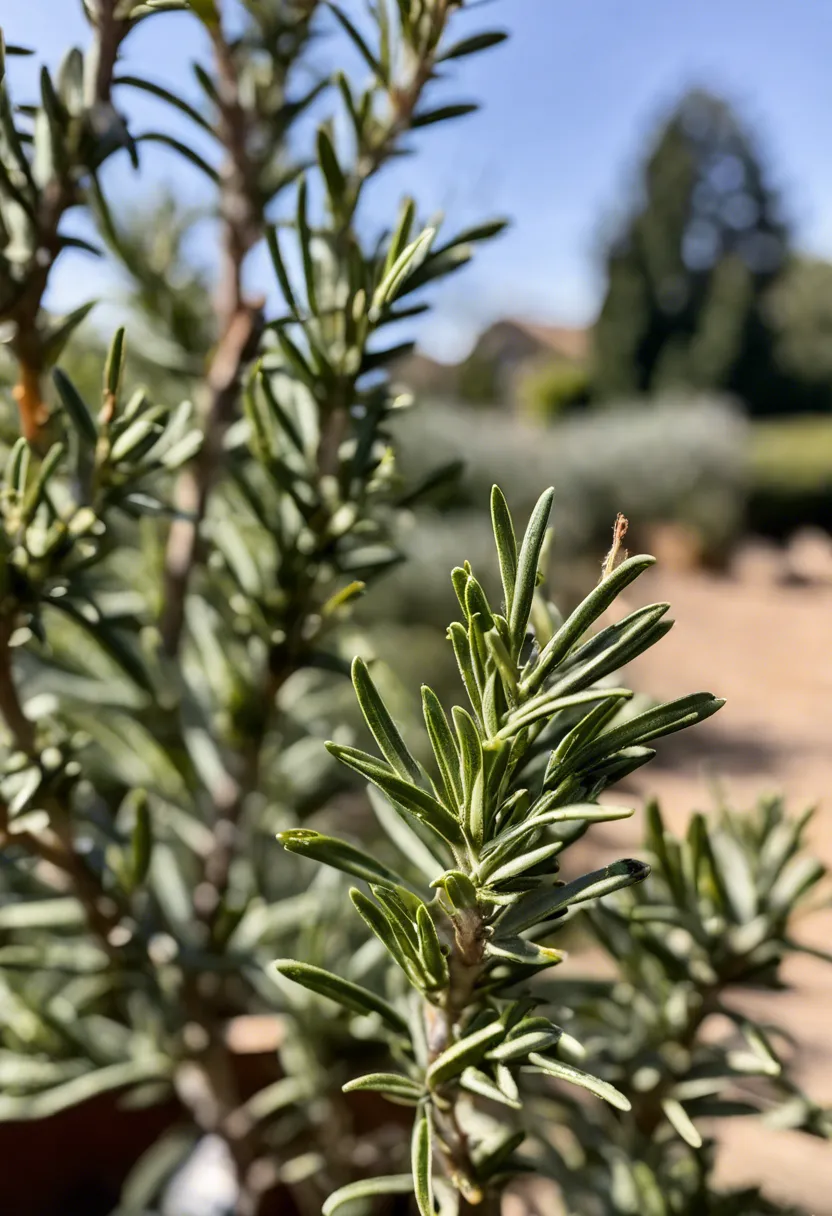Is your Rosemary Turning Brown? Fear not, you’re not alone. Many garden enthusiasts face this issue and it can be quite frustrating.
However, understanding the cause is the first step to solving it. It could be due to a number of factors like improper watering, unsuitable soil conditions or even pests and diseases.
Keep reading about Rosemary Turning Brown to get insights on how to revive your plant back to its lush green state.
Key Takeaways
- Rosemary turning brown can be due to overwatering, underwatering, lack of sunlight, or disease.
- Overwatering causes root rot which turns rosemary brown. Water only when the top inch of soil is dry.
- Underwatering makes leaves crispy and brown. Keep soil slightly moist but not soggy.
- Lack of sunlight leads to weak growth and browning. Ensure your rosemary gets at least six hours of full sun daily.
- Diseases like powdery mildew also cause browning. Use organic fungicides and ensure good air circulation around your plant.

Understanding Why Rosemary Turns Brown
Getting to the root of rosemary turning brown can feel like playing detective, but don’t worry, we’re here to crack the case. From watering mishaps to sunburns and soil faux pas, we’ll guide you through the common culprits.
The Role of Watering in Rosemary Health
Water, the essence of life, right? Well, your rosemary thinks so too but with a “less is more” attitude. Under-watering can make your plant’s leaves crispy and brown, a sign they’re thirstier than a tourist in the desert. They want a drink but not a flood. On the flip side, over-watering is like giving them water wings when they didn’t ask for them. It leads to root rot and that dreaded browning. The trick is to check the top inch of soil; if it’s dry, it’s time for a light watering. Keep it consistent but moderate – think of it as keeping your rosemary on a steady hydration diet rather than binge-drinking on weekends.
Impact of Sunlight and Temperature on Rosemary
Rosemary loves the sun like a cat finding that perfect sunny spot on the carpet, but there’s such a thing as too much love. Excessive sunlight can scorch leaves, turning them brown and sad. Aim for that sweet spot of 6-8 hours of direct sunlight daily; think morning rays rather than midday beams. Now let’s talk temperature – rosemary thrives in warm conditions but doesn’t fancy extreme heat or cold snaps. Protecting your plant from heat stress involves providing some shade during those peak scorching hours while ensuring they’re cozy (but not too cozy) during colder months. A bit like dressing them up or down depending on the weather forecast.
Effect of Soil Conditions on Rosemary Color
Soil is more than just dirt; it’s your rosemary’s home, pantry, and wardrobe all rolled into one. Getting the pH level right is crucial – aim for neutral to slightly alkaline soil because too acidic or too alkaline soils are party poopers for your herb. If your rosemary starts throwing a brown tantrum, testing soil pH might just reveal why. Next up: nutrients or lack thereof can lead to discoloration and general unhappiness in your plant’s world. Ensuring your soil is rich with all the good stuff (think compost or organic matter) will keep it vibrant and healthy-looking. Remember, happy soil equals happy rosemary; treat it like crafting the perfect bed for royalty because essentially, that’s what your plant is in its own leafy kingdom.
Common Diseases and Pests Affecting Rosemary
When your rosemary turning brown has you scratching your head, it’s time to play detective. The usual suspects? A motley crew of diseases and pests that think your rosemary is their next meal or sick bed. We’re talking about a lineup that includes everything from sneaky fungi to tiny critters with a taste for greenery. But fear not, identifying these common rosemary plant issues is the first step in defending your herb garden.
Root Rot Disease in Rosemary
Root rot in rosemary plants is like that uninvited guest at a party who just won’t leave. It usually crashes the scene due to overwatering or poor drainage, leading to soggy soil conditions where fungi thrive. Root rot symptoms include wilting, yellowing leaves, and yes, roots that look more brown mush than sturdy lifeline. If you pull up an affected plant, those roots will tell a sorry tale of decay.
Preventing this unwelcome visitor starts with saying no to the urge to water too frequently. Think of your rosemary’s need for water like a cactus, not a water lily. Ensuring soil drainage importance cannot be overstated; choose well-draining soil and consider raised beds or containers if you’re dealing with heavy clay ground. Caught early, treating root rot in rosemary involves trimming away the rotted roots and repotting in fresh soil. Sometimes tough love (and drier conditions) is what it takes to save your plant from this root disease prevention challenge.
Powdery Mildew and Its Effects on Rosemary
Imagine dusting your rosemary with flour – that’s what powdery mildew looks like. This fungal foe covers leaves with a white or grayish powder, hampering photosynthesis and stunting growth. Not exactly the seasoning you had in mind for your gourmet dishes.
Fighting back against this fluffy invader starts with cleanliness and air circulation; overcrowded plants are an open invitation for mildew parties. When it comes to organic treatments for mildew, think neem oil or baking soda solutions as gentle yet effective bouncers showing mildew the door. For those facing a severe infestation, chemical fungicides for plants can act as the big guns, ensuring powdery mildew gets the message loud and clear: it’s not welcome here. Remember, choosing mildew-resistant rosemary varieties could save you from this headache altogether – prevention is always better than cure when managing fungal disease management.
Common Pests Attacking Rosemary Plants
Spider mites and aphids have one thing in common – they love dining out on your rosemary plants as if they were at a five-star restaurant. These tiny terrors suck sap from leaves, leaving behind yellow spots or distorted growth.
Before reaching for chemical warfare (chemical pesticides for herbs), consider inviting natural predators into your garden such as ladybugs or lacewings who see aphids as their favorite snack (natural pest remedies). Creating an environment that welcomes these helpers can keep pest populations in check without harming your herbs or the planet. However, sometimes an infestation calls for stronger measures; insecticidal soaps or neem oil can offer relief without resorting to harsh chemicals. Remember, keeping an eye out for early signs of trouble (preventing garden pests) means you can often avoid turning to drastic measures by nipping problems in the bud.



Step-by-Step: How to Revive Brown Rosemary


So, your rosemary has turned as brown as a well-done steak, and you’re on the brink of writing a heartfelt eulogy for it. Before you start mourning, let’s try some plant CPR to bring that aromatic buddy back to life. Reviving brown rosemary is not just about watering it and hoping for the best; it involves a bit of detective work and some tender loving care. Let’s roll up our sleeves and get to work!
-
Assess the damage: First things first, take a good look at your rosemary. If it’s more brown than green and the soil feels like the Sahara Desert, we’ve got some work to do. But if there are still some green shoots fighting for survival, there’s hope yet!
-
Trim the dead parts: Using clean scissors or pruning shears, gently trim away all the brown and dead parts of the plant. This might feel like you’re giving your rosemary a drastic haircut, but trust me, it’s for the best. We want to redirect all its energy into reviving what’s still alive.
-
Water wisely: Over-watering can be just as bad as under-watering. The key is moderation. Give your rosemary a good drink until water runs out of the drainage holes at the bottom of its pot, then let it be until the top inch of soil is dry before watering again.
-
Check for pests: Sometimes, bugs decide your rosemary is their new home sweet home. Inspect closely for any unwelcome guests like spider mites or aphids that could be causing damage. If you spot any, a gentle shower with insecticidal soap should send them packing.
-
Move to better lighting: Rosemary loves sunlight more than a cat loves a warm lap. Make sure your plant gets at least 6-8 hours of direct sunlight daily. If natural light is scarce in your home, consider using a grow light.
-
Adjust soil conditions: Rosemary prefers well-draining soil that isn’t too rich in organic matter – think Mediterranean hillside rather than fertile valley floor. If your soil holds too much moisture or isn’t draining well, consider repotting with a mix better suited for herbs.
-
Be patient: Plants don’t operate on human time schedules; they’re more like laid-back surfers waiting for the perfect wave. It might take weeks or even months for your rosemary to show signs of revival fully.
By following these steps diligently, you stand a good chance of bringing your brown rosemary back from the brink! Remember, plants are resilient beings that have been around way longer than us humans have been trying to figure out how not to kill them by over-care or neglect.
Preventive Measures for Healthy Rosemary Growth
Alright, so your rosemary is turning brown and you’re freaking out. Don’t worry! Before we get into the nitty-gritty of solving this issue, let’s talk about how to keep your rosemary happy and healthy from the get-go. Because, let’s face it, prevention is way cooler (and easier) than cure.
-
Water wisely: Rosemary doesn’t like wet feet. Only water when the soil feels dry to the touch. Think of it like checking if a cake is done – no gooey batter means it’s time for water.
-
Let there be light: These plants are sun worshippers. Ensure they get at least 6 to 8 hours of direct sunlight daily. It’s like their version of a beach day, every day.
-
Air flow is key: Keep your rosemary in a spot where air can circulate freely around it. This helps prevent fungal diseases which are basically the boogeyman for plants.
-
Soil matters: Use well-draining soil or potting mix. Imagine wearing wet socks all day; that’s how rosemary feels in soggy soil.
-
Prune with purpose: Regularly trimming your rosemary not only keeps it looking sharp but also encourages healthy growth. It’s like a haircut but for plants.
-
Fertilize thoughtfully: Overfeeding can harm more than help. Use a balanced, slow-release fertilizer sparingly in the spring. Think of it as seasoning food; a little goes a long way.
Remember, keeping your rosemary plant healthy isn’t rocket science—it’s more like baking cookies: follow the recipe (in this case, our list), and you’ll be set up for success!


To Wrap Up
So, we’ve unraveled the mystery of Rosemary Turning Brown. It’s all about balance – too much or too little water, sunlight, humidity, and even the wrong type of soil can upset your rosemary.
Remember, it’s not just about keeping your rosemary alive but making sure it thrives. Regularly check for signs of stress and adjust care accordingly.
Finally, don’t be disheartened if you’re struggling. Gardening is a journey, full of learning curves. Keep experimenting until you find what works best for your green friend!


